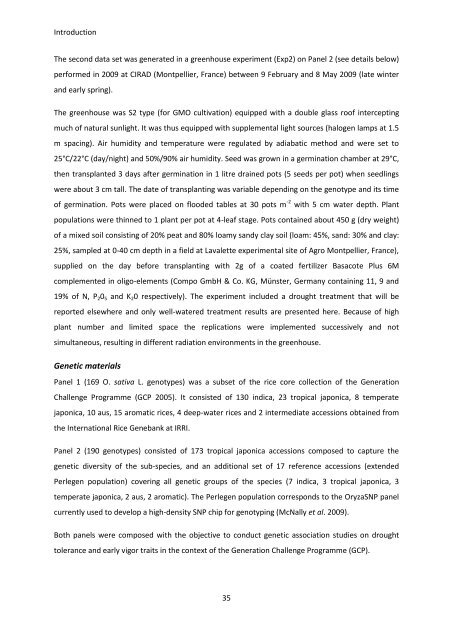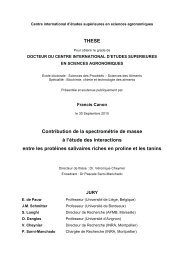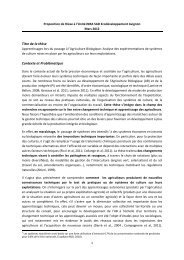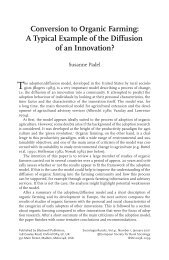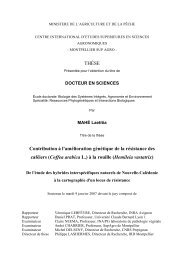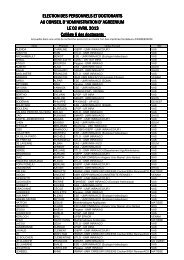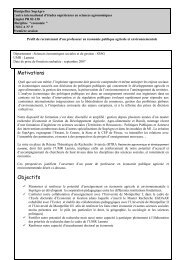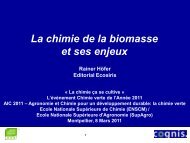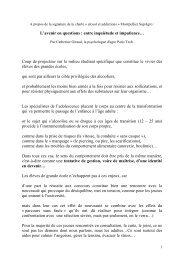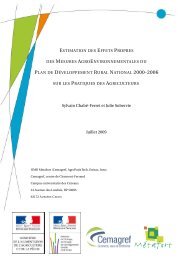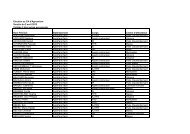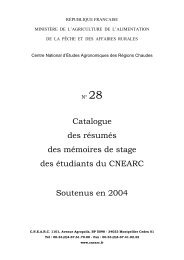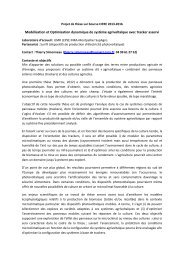Rice (Oryza sativa. L) genetic diversity for early vigor and drought ...
Rice (Oryza sativa. L) genetic diversity for early vigor and drought ...
Rice (Oryza sativa. L) genetic diversity for early vigor and drought ...
- No tags were found...
You also want an ePaper? Increase the reach of your titles
YUMPU automatically turns print PDFs into web optimized ePapers that Google loves.
IntroductionThe second data set was generated in a greenhouse experiment (Exp2) on Panel 2 (see details below)per<strong>for</strong>med in 2009 at CIRAD (Montpellier, France) between 9 February <strong>and</strong> 8 May 2009 (late winter<strong>and</strong> <strong>early</strong> spring).The greenhouse was S2 type (<strong>for</strong> GMO cultivation) equipped with a double glass roof interceptingmuch of natural sunlight. It was thus equipped with supplemental light sources (halogen lamps at 1.5m spacing). Air humidity <strong>and</strong> temperature were regulated by adiabatic method <strong>and</strong> were set to25°C/22°C (day/night) <strong>and</strong> 50%/90% air humidity. Seed was grown in a germination chamber at 29°C,then transplanted 3 days after germination in 1 litre drained pots (5 seeds per pot) when seedlingswere about 3 cm tall. The date of transplanting was variable depending on the genotype <strong>and</strong> its timeof germination. Pots were placed on flooded tables at 30 pots m -2 with 5 cm water depth. Plantpopulations were thinned to 1 plant per pot at 4-leaf stage. Pots contained about 450 g (dry weight)of a mixed soil consisting of 20% peat <strong>and</strong> 80% loamy s<strong>and</strong>y clay soil (loam: 45%, s<strong>and</strong>: 30% <strong>and</strong> clay:25%, sampled at 0-40 cm depth in a field at Lavalette experimental site of Agro Montpellier, France),supplied on the day be<strong>for</strong>e transplanting with 2g of a coated fertilizer Basacote Plus 6Mcomplemented in oligo-elements (Compo GmbH & Co. KG, Münster, Germany containing 11, 9 <strong>and</strong>19% of N, P 2 0 5 <strong>and</strong> K 2 0 respectively). The experiment included a <strong>drought</strong> treatment that will bereported elsewhere <strong>and</strong> only well-watered treatment results are presented here. Because of highplant number <strong>and</strong> limited space the replications were implemented successively <strong>and</strong> notsimultaneous, resulting in different radiation environments in the greenhouse.Genetic materialsPanel 1 (169 O. <strong>sativa</strong> L. genotypes) was a subset of the rice core collection of the GenerationChallenge Programme (GCP 2005). It consisted of 130 indica, 23 tropical japonica, 8 temperatejaponica, 10 aus, 15 aromatic rices, 4 deep-water rices <strong>and</strong> 2 intermediate accessions obtained fromthe International <strong>Rice</strong> Genebank at IRRI.Panel 2 (190 genotypes) consisted of 173 tropical japonica accessions composed to capture the<strong>genetic</strong> <strong>diversity</strong> of the sub-species, <strong>and</strong> an additional set of 17 reference accessions (extendedPerlegen population) covering all <strong>genetic</strong> groups of the species (7 indica, 3 tropical japonica, 3temperate japonica, 2 aus, 2 aromatic). The Perlegen population corresponds to the <strong>Oryza</strong>SNP panelcurrently used to develop a high-density SNP chip <strong>for</strong> genotyping (McNally et al. 2009).Both panels were composed with the objective to conduct <strong>genetic</strong> association studies on <strong>drought</strong>tolerance <strong>and</strong> <strong>early</strong> <strong>vigor</strong> traits in the context of the Generation Challenge Programme (GCP).35


